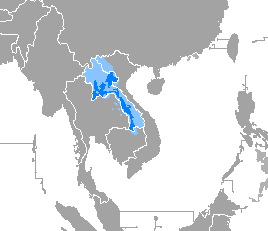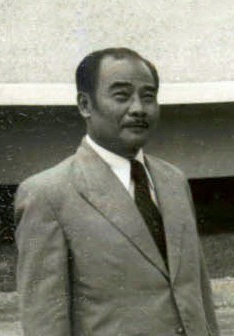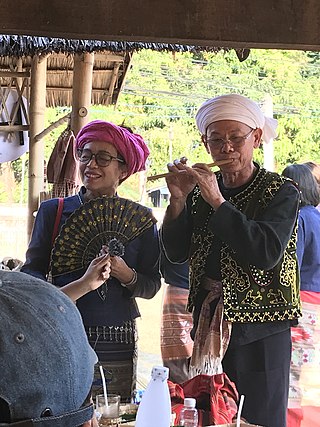Related Research Articles

Laos, officially the Lao People's Democratic Republic, is the only landlocked country in Southeast Asia. At the heart of the Indochinese Peninsula, Laos is bordered by Myanmar and China to the northwest, Vietnam to the east, Cambodia to the southeast, and Thailand to the west and southwest. Its capital and largest city is Vientiane.

Evidence of modern human presence in the northern and central highlands of Indochina, which constitute the territories of the modern Laotian nation-state, dates back to the Lower Paleolithic. These earliest human migrants are Australo-Melanesians—associated with the Hoabinhian culture—and have populated the highlands and the interior, less accessible regions of Laos and all of Southeast Asia to this day. The subsequent Austroasiatic and Austronesian marine migration waves affected landlocked Laos only marginally, and direct Chinese and Indian cultural contact had a greater impact on the country.

The Hmong people are an indigenous group in East Asia and Southeast Asia. In China, the Hmong people are classified as a sub-group of the Miao people. The modern Hmong reside mainly in Southwest China and countries in Southeast Asia such as Vietnam, Laos, Thailand, and Myanmar. There is also a large diasporic community in the United States of more than 300,000. The Hmong diaspora has smaller communities in Australia and South America.

Lao, sometimes referred to as Laotian, is the official language of Laos and a significant language in the Isan region of northeastern Thailand, where it is usually referred to as the Isan language. Spoken by over 3 million people in Laos and 3.2 million in all countries, it serves as a vital link in the cultural and social fabric of these areas. It is written in the Lao script, an abugida that evolved from ancient Tai scripts.

The Lao people are a Tai ethnic group native to Southeast Asia, who speak the Lao language of the Kra–Dai languages. They are the majority ethnic group of Laos, making up 53.2% of the total population. The majority of Lao people adhere to Theravada Buddhism. They are closely related to other Tai people, especially with the Isan people, who are also speakers of Lao language, native to neighboring Thailand.

Prince Souphanouvong, nicknamed the Red Prince, was along with his half-brother Prince Souvanna Phouma and Prince Boun Oum of Champasak, one of the "Three Princes" who represented respectively the communist (pro-Vietnam), neutralist and royalist political factions in Laos. He was the President of Laos from December 1975 to October 1986.

The Laotian Civil War was waged between the Communist Pathet Lao and the Royal Lao Government from 23 May 1959 to 2 December 1975. The Kingdom of Laos was a covert theater during the Vietnam War with both sides receiving heavy external support in a proxy war between the global Cold War superpowers. The fighting also involved the North Vietnamese, South Vietnamese, American and Thai armies, both directly and through irregular proxies. The war is known as the Secret War among the American CIA Special Activities Center, and Hmong and Mien veterans of the conflict.

Romvong, Lamvong or Ramwong, Rambung, Vietnamese: lăm-vông) is a type of Southeast Asian dance where both females and males dance in a circle. It is a popular folk-dance in Cambodia, Laos, Malaysia, Xishuangbanna (China), and Thailand. It is a slow round dance continuously moving in a circular manner, and incorporates graceful hand movements and simple footwork. Both men and women participate in the same circle.

Laos developed its culture and customs as the inland crossroads of trade and migration in Southeast Asia over millennia. As of 2012 Laos has a population of roughly 6.4 million spread over 236,800 km2, yielding one of the lowest population densities in Asia. Yet the country of Laos has an official count of over forty-seven ethnicities divided into 149 sub-groups and 80 different languages. The Lao Loum have throughout the country's history comprised the ethnic and linguistic majority. In Southeast Asia, traditional Lao culture is considered one of the Indic cultures.
Tai Dam, also known as Black Tai, is a Tai language spoken by the Tai Dam in Vietnam, Laos, Thailand, and China.

The French protectorate of Laos was a French protectorate in Southeast Asia of what is today Laos between 1893 and 1953—with a brief interregnum as a Japanese puppet state in 1945—which constituted part of French Indochina. It was established over the Siamese vassal, the Kingdom of Luang Phrabang, following the Franco-Siamese crisis of 1893. It was integrated into French Indochina and in the following years further Siamese vassals, the Principality of Phuan and Kingdom of Champasak, were annexed into it in 1899 and 1904, respectively.

Thai Sign Language, or Modern Standard Thai Sign Language (MSTSL), is the national sign language of Thailand's deaf community and is used in most parts of the country by the 20 percent of the estimated 56,000 pre-linguistically deaf people who go to school.

The largest of the ethnic groups in Cambodia are the Khmer, who comprise 95.8% of the total population and primarily inhabit the lowland Mekong subregion and the central plains. The Khmer historically have lived near the lower Mekong River in a contiguous arc that runs from the southern Khorat Plateau where modern-day Thailand, Laos and Cambodia meet in the northeast, stretching southwest through the lands surrounding Tonle Sap lake to the Cardamom Mountains, then continues back southeast to the mouth of the Mekong River in southeastern Vietnam.
The three deaf-community sign languages indigenous to Vietnam are found in Ho Chi Minh City, Hanoi, and Haiphong. The HCMC and Hanoi languages especially have been influenced by the French Sign Language (LSF) once taught in schools, and have absorbed a large amount of LSF vocabulary.

The Tai Lü people are an ethnic group of China, Laos, Thailand, Burma and Vietnam. They speak a Southwestern Tai language.

The Southwestern Tai or Thailanguages are a branch of the Tai languages of Southeast Asia. Its languages include Central Thai (Siamese), Northern Thai (Lanna), Lao, Shan and others.
Haiphong Sign Language is the deaf-community sign language of the city of Haiphong in Vietnam. It is about 50% cognate with the other sign languages of Vietnam, and has been less influenced than them by the French Sign Language once taught in Vietnamese schools for the deaf. It shares cognates with the languages of the Old Chiangmai–Bangkok Sign Language family of Thailand; the deaf-community sign languages of Vietnam, Thailand and Laos may be genealogically related, or there may be a history of population movement that has cause them to have words in common.
There is a large community of Vietnamese people in Laos. As Vietnam and Laos are neighbours, there is a long history of population migrations between the territories which today make up the two respective countries.

The Kuy are an indigenous ethnic group of mainland Southeast Asia. The native lands of the Kuy range from the southern Khorat Plateau in northeast Thailand east to the banks of the Mekong River in southern Laos and south to north central Cambodia. The Kuy are an ethnic minority in all three countries, where they live as "hill tribes" or Montagnards. Their language is classified as a Katuic language of the Mon-Khmer language family. The Thais, Lao, and Khmer traditionally recognize the Kuy as the aboriginal inhabitants of the region. The word kuy in the Kuy language means "people" or "human being"; alternate English spellings include Kui, Kuoy and Kuay, while forms similar to "Suay" or "Suei" are derived from the Thai/Lao exonyms meaning "those who pay tribute". The Kuy are known as skilled mahouts, or elephant trainers, and many Kuy villages are employed in finding, taming, and selling elephants.
References
- ↑ Laotian sign languages at Ethnologue (25th ed., 2022)
